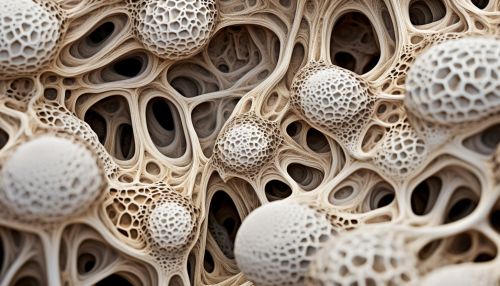Biomineralization
Introduction
Biomineralization is a naturally occurring biological process that leads to the formation of minerals or mineralized tissues in living organisms. This process involves the interaction of organic and inorganic substances, resulting in the production of materials with unique physical and chemical properties. Biomineralization is a critical process in various biological systems and is responsible for the formation of structures such as bones, teeth, and shells in animals, and silica bodies in plants read more.
Biological Significance
Biomineralization plays a crucial role in the survival and evolution of many species. The minerals formed through this process are often used to create structural components in organisms. For example, the calcium carbonate in mollusk shells and the hydroxyapatite in vertebrate bones and teeth are products of biomineralization. These structures provide protection, support, and mechanical strength to the organisms, enabling them to survive in their respective environments.
Mechanisms of Biomineralization
Biomineralization can occur through several distinct mechanisms, including biologically controlled and biologically induced mineralization.
Biologically Controlled Mineralization
In biologically controlled mineralization, the organism exerts precise control over the mineral formation process. This includes control over the location, rate, and orientation of mineral growth, as well as the type and morphology of the mineral formed. This process is often associated with the formation of hard tissues such as bones and teeth.
Biologically Induced Mineralization
Biologically induced mineralization is a less controlled process where the organism provides a suitable environment for mineral formation, but does not directly control the process. This type of mineralization often occurs in response to environmental conditions and can result in the formation of minerals on the surface of the organism or within its tissues.
Types of Biominerals
There are several types of biominerals, each with unique properties and functions. These include calcium carbonate, calcium phosphate, silica, and iron minerals.
Calcium Carbonate
Calcium carbonate is one of the most common biominerals and is found in a wide range of organisms, including mollusks, echinoderms, and some species of algae. It is often used to form protective shells and exoskeletons.
Calcium Phosphate
Calcium phosphate, specifically in the form of hydroxyapatite, is the primary mineral found in vertebrate bones and teeth. It provides strength and rigidity to these structures.
Silica
Silica is a common biomineral in many plant species and some types of sponges. In plants, silica bodies provide structural support and protection against herbivores.
Iron Minerals
Iron minerals are found in a variety of organisms, including bacteria, mollusks, and birds. They are often involved in magnetic sensing and iron storage.


Biomineralization in Human Health and Disease
Biomineralization plays a critical role in human health, particularly in the formation and maintenance of bone and tooth tissues. However, abnormal biomineralization can lead to various health problems, including kidney stones, gallstones, and certain types of arthritis. Understanding the mechanisms of biomineralization can therefore have important implications for the prevention and treatment of these conditions.
Biomineralization in Biotechnology and Materials Science
The unique properties of biominerals and the precision with which organisms can control their formation have led to interest in harnessing biomineralization for use in biotechnology and materials science. This includes the development of new materials with improved mechanical properties, the creation of bio-inspired materials for medical applications, and the use of biomineralization processes for environmental remediation.
